We had thunder and rain this afternoon for several hours, but around six, sun broke through enough to illuminate the newly refilled lily pond. I went out to see what was going on with pondlife. Two male Neon Skimmers, Libellula croceipennis, were harrassing the four or five male Blue Dashers, Pachydiplax longipennis, and also pestering the two female Neon Skimmers who were ovipositing in the pond.
Neon Skimmer females “splash-deliver” their eggs onto mats of algae or waterside vegetation. They hover over the water, then dip down and use the tip of the abdomen as a sort of scoop to splash the water forward, instantly rising again. The droplets of water contain the eggs. This female oviposited constantly over a several minute period, moving from one area of the pond to another.
But along with odonates, this pond contains a variety of pond life–water striders, giant water bugs, tadpoles, frogs, and usually one of the small water snakes. And fishing spiders, which in summer grow to be quite large.
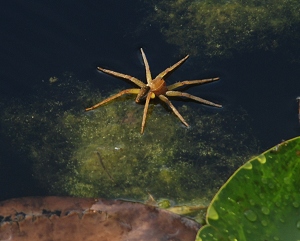 Six-spotted Fishing Spider, Dolomedes triton
Six-spotted Fishing Spider, Dolomedes triton
Fishing spiders spend much of their time in the water lilies, under the leaves that extend above the water. This one, I noticed, was attracted by the water movement of the ovipositing female as she splash-deposited her eggs.
At this point, I thought “What if she gets too close–will the spider attack?” The spider waited.
Then:
She came too close; the spider jumped (alas, no picture of that leap) and grabbed; its weight bore the dragonfly down and it quickly scrambled into position to bite. The dragonfly fluttered strongly, trying to break free, but in addition to the bite the spider had legs on the dragonfly’s wings.
Gradually, the dragonfly’s struggles ceased, the wing movements coming farther and farther apart.
When I moved around the end of the pond to get a vertical view of what the spider was doing (besides killing a large dragonfly) the spider retreated to the cover of the lily pads, leaving the paralyzed dragonfly glowing in the slanting sun:
I’m sure the spider came back after I left. Meanwhile the other creatures of the pond went on about their business.
One of the Blue Dasher males took a breather from harrassing other small dragonflies, and below, a Hackberry Emperor butterfly suns on a water iris leaf.
It’s unusual that I get to witness predation on this scale–I really like Neon Skimmers and hoped this one wouldn’t be caught–or would get away–but if it had to be, I’m glad I was there to document it.
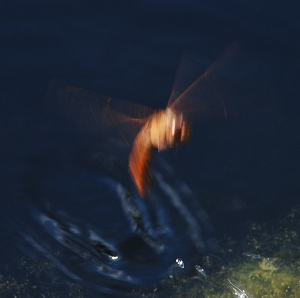
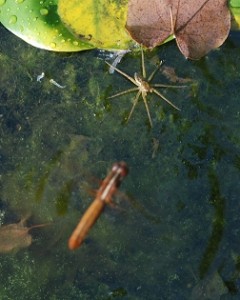
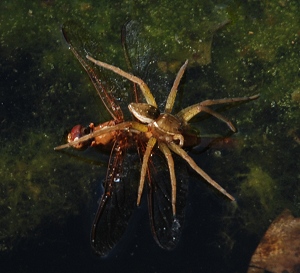
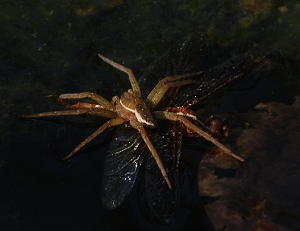
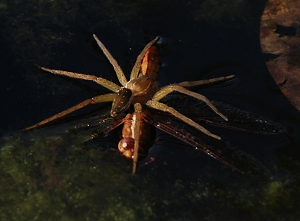
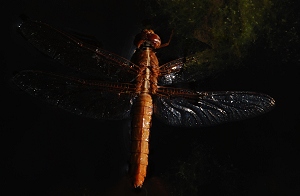
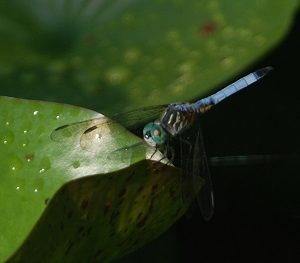
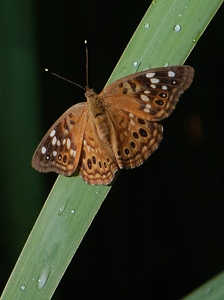
Comment by Doranna — June 29, 2010 @ 9:50 pm
Pretty amazing set of pics!
Comment by Anne Bussell — June 29, 2010 @ 10:51 pm
Wow. Amazing.
Comment by elizabeth — June 29, 2010 @ 11:01 pm
When I saw the dragonfly getting closer and closer to the spider, I worried–but couldn’t think of anything to do…the spider had actually moved from my end of the pond–when the dragonfly was there–to the north side–apparently following the splashes but going through the water lily tangles. I really, really like Neon Skimmers and want more of them, but having a pond ecosystem means sometimes one predator eats another.
Comment by Steve Willson — June 30, 2010 @ 5:36 am
That’s really a neat series of photos. Hopefully the dragonfly got plenty of eggs laid before she was caught. That Fishing Spider is amazing. You know you’ve created a healthy ecosystem when it can support upper level predators.
Comment by elizabeth — June 30, 2010 @ 8:33 am
That particular dragonfly had been ovipositing even before I got to the pond (I saw her from a distance going up and down, up and down) and for some ??? minutes after as I was trying to photograph her. So I’m sure some of her eggs made it into the water and the algae mat.
I was glad there were two females ovipositing, though. Our dragonfly diversity isn’t what it was before the recent hard drought…this system wasn’t designed just for odes and isn’t big enough to support all the species I’ve seen elsewhere on the place. And we don’t have the rain-collection area or storage to supply anything bigger.
Comment by Kathy Biggs — June 30, 2010 @ 12:59 pm
Wonderful to photo (& TEXT) document this!
The spiders on my Calif. pond don’t get that large….wowie! I think I’ll share this with our CalOdes group!
Comment by elizabeth — June 30, 2010 @ 2:06 pm
Glad you enjoyed it. When I first see these spiders in the spring, they’re about the size of my fingernail–but they grow fast. This is not the biggest I ever saw. Last year when we were doing some serious work in the pond system, my husband was not thrilled with the number of big fishing spiders he disturbed. You probably already recognized it, but if not, it’s a Six-spotted Fishing Spider, Dolomedes triton. (I need to add the species names to the post.)
Today I saw a Widow Skimmer ovipositing in the pond–very different pattern of movement–hovers higher, dips only once in each location and zips to the next usually 2+ feet away–may return to the original area of the pond, but again skips around. If only I didn’t have deadlines to meet I’d be out there MUCH more!
Comment by Martin LaBar — June 30, 2010 @ 7:20 pm
This is a great essay.
Comment by Adrian — July 2, 2010 @ 12:33 pm
Good thing you’re quick with a camera. Death is ever present. Yesterday watched a robin snatch a butterfly out of the air & then prevented my neighbor’s cat from stalking a semi-tame mourning dove.